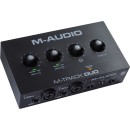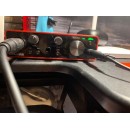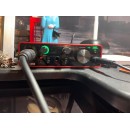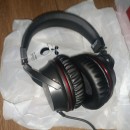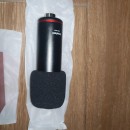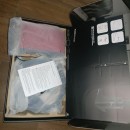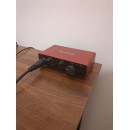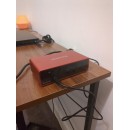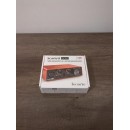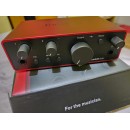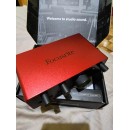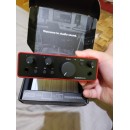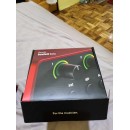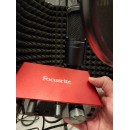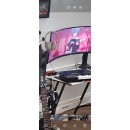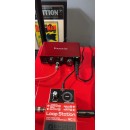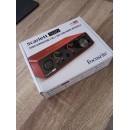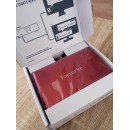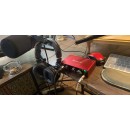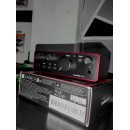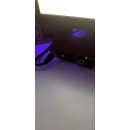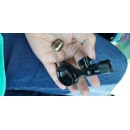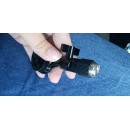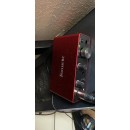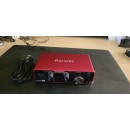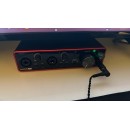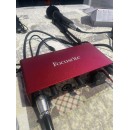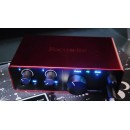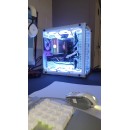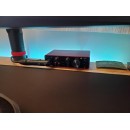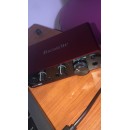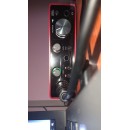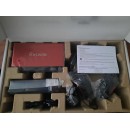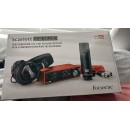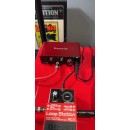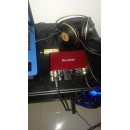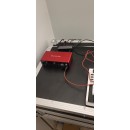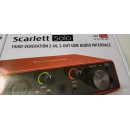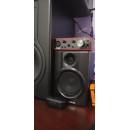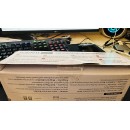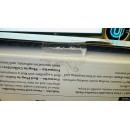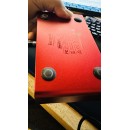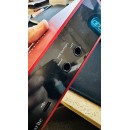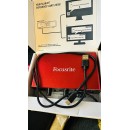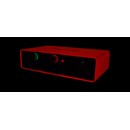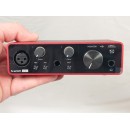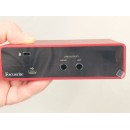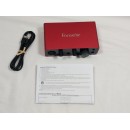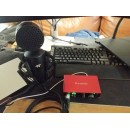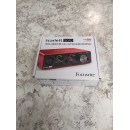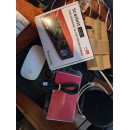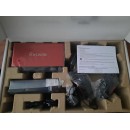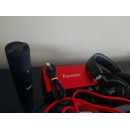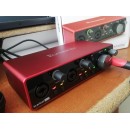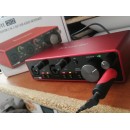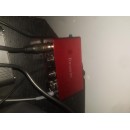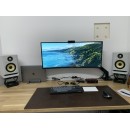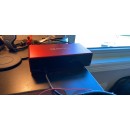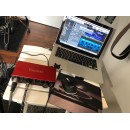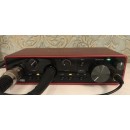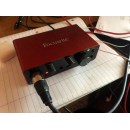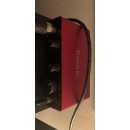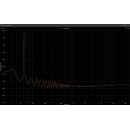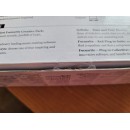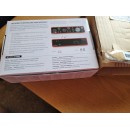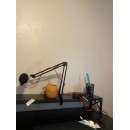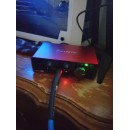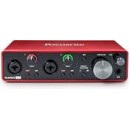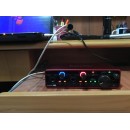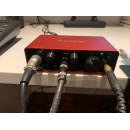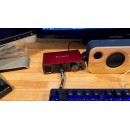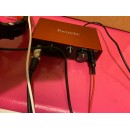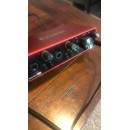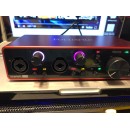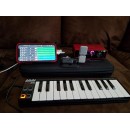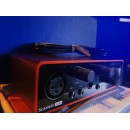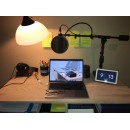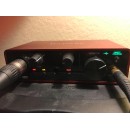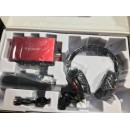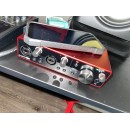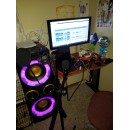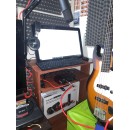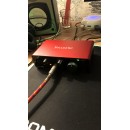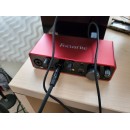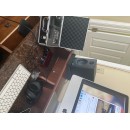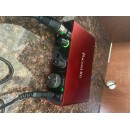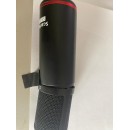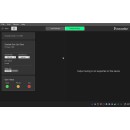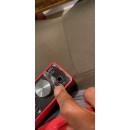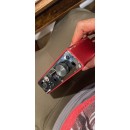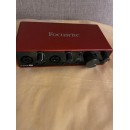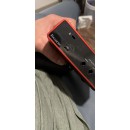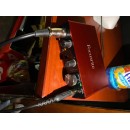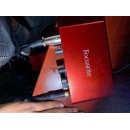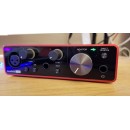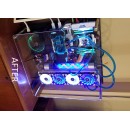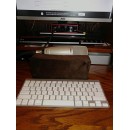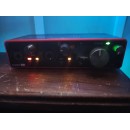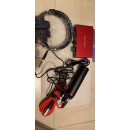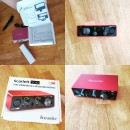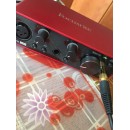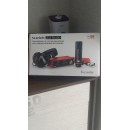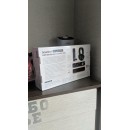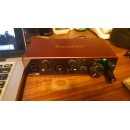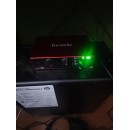M-Audio M-Track Duo vs Focusrite Scarlett 2i2: Which Audio Interface is Right for You?
The Focusrite Scarlett 2i2 (4th Generation) is renowned for its exceptional audio quality, boasting a dynamic range of 120dB. This model features two award-winning mic preamps with switchable Air mode, which enhances high-end detail to give recordings a brighter, more spacious sound. The USB-C connectivity ensures low latency and high-speed data transfer, making it a reliable choice for modern setups. The Scarlett 2i2 also includes a comprehensive software bundle, featuring Ableton Live Lite, Pro Tools First, and a variety of plug-ins, providing a robust toolkit for music production.
In contrast, the M-Audio M-Track Duo is a more budget-friendly option, providing solid performance for its price range. It features two combo inputs with Crystal preamps, which offer clear and transparent sound. The M-Track Duo uses USB-B connectivity, which is slightly older technology compared to USB-C, but it still maintains reliable performance. This interface also supports direct monitoring with a dedicated switch, allowing users to hear their input signal with zero latency. While the software package is not as extensive as the Scarlett’s, it includes essential tools like MPC Beats, making it a great entry-level option.
In summary, the Focusrite Scarlett 2i2 (4th Generation) stands out with its superior audio quality, innovative Air mode, and extensive software bundle, making it ideal for professionals and serious hobbyists. The M-Audio M-Track Duo, on the other hand, offers excellent value with essential features and reliable performance, making it a solid choice for beginners or those on a budget. Each interface has its strengths, catering to different user needs and experience levels.
In-Depth Comparison: M-Audio M-Track Duo and Focusrite Scarlett 2i2 (4th Gen)
| User Rating Based on Analysis of Reviews | |
|---|---|
|
Show More |
| Pros: | |
|---|---|
|
|
| Cons: | |
|---|---|
|
|
| Key Specs | |
|---|---|
| Channels of I/O | |
| Analog: 2 Inputs / 2 Outputs at 192 kHz |
Analog: 2 Inputs / 2 Outputs at 192 kHz |
| Maximum Sampling Rate | |
| 192 kHz / 24-Bit | 48 kHz / 24-Bit |
| Number of Microphone Inputs | |
| 2 | 2 Preamps |
| Analog Audio I/O | |
| 2x XLR 3-Pin Balanced Mic Input 2x 1/4" TRS Balanced/Unbalanced Line/Hi-Z Input (Front Panel) 2x 1/4" TRS Balanced Monitor Output 1x 1/4" TRS Headphone Output (Front Panel) |
2x Combo XLR-1/4" TRS Balanced/Unbalanced Mic/Line/Hi-Z Input (Front Panel) 2x 1/4" TRS Balanced Line Output 1x 1/4" TRS Unbalanced Headphone Output (Front Panel) |
| Host Connection | |
| 1x USB-C | 1x USB-B (Class-Compliant) |
| OS Compatibility | |
| macOS Windows |
macOS 10.8 or Later Windows 7 or Later (32-/64-Bit) |
| Power Requirements | |
| USB Bus Power, USB Power Adapter (Not Included) | USB Bus Power |
The Focusrite Scarlett 2i2 (4th Gen) offers a maximum sampling rate of 192 kHz at 24-bit resolution, which is notably higher than the M-Audio M-Track Duo's 48 kHz at 24-bit. This higher sampling rate in the Scarlett 2i2 allows for more detailed and accurate audio recordings, making it a preferred choice for professionals seeking high-fidelity recordings. Both interfaces provide 2 analog inputs and 2 analog outputs, but the Scarlett 2i2 utilizes USB-C for its host connection, ensuring faster data transfer speeds and better compatibility with modern devices, while the M-Audio M-Track Duo uses the older USB-B interface.
In terms of microphone inputs, both interfaces offer 2 preamps, but the Scarlett 2i2's inputs are XLR 3-Pin Balanced Mic Inputs and 1/4" TRS Balanced/Unbalanced Line/Hi-Z Inputs, providing versatile connectivity options. The M-Audio M-Track Duo also offers 2 Combo XLR-1/4" TRS Balanced/Unbalanced Mic/Line/Hi-Z Inputs, which similarly accommodates various input types but with less clarity regarding the types of connections supported.
For analog audio I/O, the Scarlett 2i2 includes 2x XLR 3-Pin Balanced Mic Inputs, 2x 1/4" TRS Balanced/Unbalanced Line/Hi-Z Inputs (Front Panel), 2x 1/4" TRS Balanced Monitor Outputs, and 1x 1/4" TRS Headphone Output (Front Panel). On the other hand, the M-Audio M-Track Duo features 2x Combo XLR-1/4" TRS Balanced/Unbalanced Mic/Line/Hi-Z Inputs (Front Panel), 2x 1/4" TRS Balanced Line Outputs, and 1x 1/4" TRS Unbalanced Headphone Output (Front Panel). These configurations indicate that both devices are designed to handle similar input types, but the Scarlett 2i2 includes balanced monitor outputs for better sound quality in professional monitoring environments.
Regarding operating system compatibility, the Focusrite Scarlett 2i2 works with both macOS and Windows, whereas the M-Audio M-Track Duo specifies compatibility with macOS 10.8 or later and Windows 7 or later (32-/64-bit). Both interfaces are USB bus-powered, but the Scarlett 2i2 also offers the option to use a USB power adapter, providing additional power stability when needed.
In summary, while both interfaces offer essential features for audio recording, the Focusrite Scarlett 2i2 USB-C Audio Interface (4th Generation) stands out with its higher sampling rate, faster USB-C connection, and balanced monitor outputs, making it a more advanced choice for professional audio recording. The M-Audio M-Track Duo, with its lower sampling rate and USB-B connection, is more suited for users looking for a more budget-friendly option with basic recording needs.
| General | |
|---|---|
| Channels of I/O | |
| Analog: 2 Inputs / 2 Outputs at 192 kHz |
Analog: 2 Inputs / 2 Outputs at 192 kHz |
| Maximum Sampling Rate | |
| 192 kHz / 24-Bit | 48 kHz / 24-Bit |
| Number of Microphone Inputs | |
| 2 | 2 Preamps |
| Input Level Adjustment | |
| 2x Knob | 2x Knob |
| Expansion Slots | |
However, there are notable differences between these two interfaces. The Focusrite Scarlett 2i2 boasts a higher maximum sampling rate of 192 kHz / 24-bit, which can capture more detailed audio compared to the M-Audio M-Track Duo's maximum sampling rate of 48 kHz / 24-bit. This makes the Scarlett 2i2 a better choice for those who require higher fidelity recordings. Additionally, the Focusrite Scarlett 2i2 utilizes a USB-C connection, offering potentially faster data transfer speeds and greater compatibility with modern devices, whereas the M-Audio M-Track Duo uses a USB-B connection, which is more common but generally slower.
In summary, while both interfaces offer similar basic features such as 2 inputs/outputs, microphone preamps, and input level adjustment knobs, the Focusrite Scarlett 2i2 stands out with its higher sampling rate and USB-C connectivity. This makes it more suitable for users seeking higher audio quality and modern connectivity options. The M-Audio M-Track Duo, on the other hand, offers a more basic and potentially more cost-effective solution, though with lower sampling capabilities and older USB-B connectivity.
| Signal Processing | |
|---|---|
| Gain/Trim Range | |
| Mic/Line Inputs: Up to +69 dB Hi-Z Inputs: 62 dB |
Mic Inputs: Up to +60 dB Line/Hi-Z Inputs: Up to +50 dB |
The Focusrite Scarlett 2i2 offers a substantial gain/trim range for its inputs. Specifically, it provides up to +69 dB for mic/line inputs and 62 dB for Hi-Z inputs. This extensive gain range makes it suitable for capturing a wide array of sound sources, from quiet vocals to loud instruments, with high fidelity.
On the other hand, the M-Audio M-Track Duo offers a more limited gain range. It provides up to +60 dB for mic inputs and up to +50 dB for line/Hi-Z inputs. While this range is sufficient for many recording scenarios, it is less versatile compared to the Scarlett 2i2, particularly for situations requiring higher gain.
Additionally, the M-Audio M-Track Duo lacks several features that may be important for some users. It does not include a pad feature, which is useful for attenuating strong signals to prevent clipping. Furthermore, it lacks a high-pass filter for reducing low-frequency noise and does not offer solo or mute functions, which can be critical for detailed mixing and monitoring.
In contrast, the Focusrite Scarlett 2i2 is designed with these considerations in mind, making it a more comprehensive solution for professional and home studio recording needs. Overall, the Scarlett 2i2's higher gain range and additional features make it a more versatile and robust audio interface compared to the M-Audio M-Track Duo.
| Connectivity | |
|---|---|
| Analog Audio I/O | |
| 2x XLR 3-Pin Balanced Mic Input 2x 1/4" TRS Balanced/Unbalanced Line/Hi-Z Input (Front Panel) 2x 1/4" TRS Balanced Monitor Output 1x 1/4" TRS Headphone Output (Front Panel) |
2x Combo XLR-1/4" TRS Balanced/Unbalanced Mic/Line/Hi-Z Input (Front Panel) 2x 1/4" TRS Balanced Line Output 1x 1/4" TRS Unbalanced Headphone Output (Front Panel) |
| Phantom Power | |
| 48 V, Selectable On/Off | 48 V, Selectable On/Off (Applied to All Inputs) |
| Digital Audio I/O | |
| Host Connection | |
| 1x USB-C | 1x USB-B (Class-Compliant) |
| Host Connection Protocol | |
| USB 2.0 | USB 2.0 |
| USB (Non-Host) | |
| 1x USB-C (Power Input) | |
| Sync I/O | |
| Network I/O | |
| MIDI I/O | |
In terms of analog audio I/O, the Focusrite Scarlett 2i2 offers 2x XLR 3-pin balanced mic inputs and 2x 1/4" TRS balanced/unbalanced line/Hi-Z inputs on the front panel, along with 2x 1/4" TRS balanced monitor outputs and 1x 1/4" TRS headphone output also on the front panel. On the other hand, the M-Audio M-Track Duo features 2x combo XLR-1/4" TRS balanced/unbalanced mic/line/Hi-Z inputs on the front panel, 2x 1/4" TRS balanced line outputs, and 1x 1/4" TRS unbalanced headphone output on the front panel. Both interfaces provide a good range of input and output options, with the Focusrite Scarlett 2i2 offering a dedicated XLR input.
Both interfaces provide 48V phantom power, selectable on and off, which is essential for using condenser microphones. However, while the Focusrite Scarlett 2i2 allows for specific input selection, the M-Audio M-Track Duo applies phantom power to all inputs simultaneously.
Regarding digital audio I/O, neither interface offers digital audio connections. This means that users relying solely on analog I/O can use both interfaces without the need for additional digital connections.
For host connection, the Focusrite Scarlett 2i2 uses a USB-C connection with USB 2.0 protocol, whereas the M-Audio M-Track Duo utilizes a USB-B connection with a class-compliant USB 2.0 protocol. The USB-C connection of the Scarlett 2i2 may offer more modern compatibility with newer devices and potentially better data transfer speeds.
Neither interface includes additional USB (non-host), sync I/O, network I/O, MIDI I/O, or wireless capabilities, making them both straightforward and focused on core audio recording and playback functionalities.
In summary, the Focusrite Scarlett 2i2 and the M-Audio M-Track Duo are both capable audio interfaces suitable for different types of users. The Scarlett 2i2 offers a slightly more modern connection type and dedicated XLR inputs, while the M-Track Duo provides combo inputs that can accommodate a wider range of connections. Both interfaces deliver essential features like phantom power and balanced/unbalanced I/O options, making them strong contenders in their respective categories.
| Performance | |
|---|---|
| Frequency Response | |
| XLR Mic Inputs: 20 Hz to 20 kHz ±0.06 dB 1/4" Line Inputs: 20 Hz to 20 kHz 0.05 dB 1/4" Hi-Z Inputs: 20 Hz to 20 kHz 0.15 dB |
Mic, Line, Hi-Z Inputs: 20 Hz to 20 kHz +0.1 dB Monitor Outputs: 20 Hz to 20 kHz +0.1 dB Headphone Outputs: 20 Hz to 20 kHz +0.5 dB |
| Maximum Output Level | |
| 1/4" Line: +16 dBu |
Line Outputs: +4 dBu |
| Headphone Output Power | |
| 1/4": 32 mW into 33 Ohms 22 mW into 300 Ohms |
60 mW per Channel into 32 Ohms |
| Impedance | |
| XLR Mic Inputs: 3 Kilohms 1/4" Line Inputs: 60 Kilohms 1/4" Hi-Z Inputs: 1 Megohms 1/4" Line Outputs: 100 Ohms 1/4" Headphone Outputs: < 50 Ohm |
Hi-Z Inputs: 1 Megohm (Unbalanced) |
| THD+N | |
| XLR Mic Inputs: -100 dB (at 8 dB Gain) 1/4" Line Inputs: -100 dB (at 8 dB Gain) 1/4" Hi-Z Inputs: -80 dB (at Minimum Gain) 1/4" Line Outputs: -109 dB 1/4" Headphone Outputs: -99 dB (at 33 Ohms) -108 dB (at 300 Ohms) Digital A/D Converters: -110 dB Digital D/A Converters: -115 dB |
Mic Inputs: 0.003% (A-Weighted, Min Gain, at 0 dBu) Hi-Z Inputs: 0.005% (A-Weighted, Min Gain, at 0 dBu) Headphone Outputs: 0.02% (A-Weighted) |
| EIN | |
| XLR Mic Inputs: -127 dBu A-Weighted |
Mic Inputs: -128 dBu A-Weighted (Max Gain) |
Frequency Response: The Focusrite Scarlett 2i2 offers a frequency response of 20 Hz to 20 kHz with very low deviation across different inputs: XLR Mic Inputs at ±0.06 dB, 1/4" Line Inputs at ±0.05 dB, and 1/4" Hi-Z Inputs at ±0.15 dB. Meanwhile, the M-Audio M-Track Duo provides a frequency response of 20 Hz to 20 kHz with a slightly higher deviation for Hi-Z Inputs at +0.1 dB and Headphone Outputs at +0.5 dB. Overall, the Focusrite Scarlett 2i2 has a slightly tighter tolerance in frequency response across its inputs.
Maximum Input and Output Levels: The Focusrite Scarlett 2i2 offers a maximum input level of 16 dBu for XLR Mic, 22 dBu for 1/4" Line, and 12 dBu for 1/4" Hi-Z inputs. It provides a maximum output level of +16 dBu for 1/4" Line Outputs. On the other hand, the M-Audio M-Track Duo lists its maximum output level for Line Outputs at +4 dBu. This indicates that the Scarlett 2i2 can handle higher input levels and offers higher output levels, making it more suitable for professional use.
Headphone Output Power: The Focusrite Scarlett 2i2 provides 32 mW into 33 Ohms and 22 mW into 300 Ohms for its headphone output, while the M-Audio M-Track Duo offers 60 mW per channel into 32 Ohms. The M-Track Duo provides higher power for headphones into 32 Ohms, which might offer a louder and potentially clearer headphone monitoring experience at lower impedances.
Impedance: The Focusrite Scarlett 2i2 has an impedance of 3 Kilohms for XLR Mic Inputs, 60 Kilohms for 1/4" Line Inputs, 1 Megohm for 1/4" Hi-Z Inputs, 100 Ohms for 1/4" Line Outputs, and less than 50 Ohms for 1/4" Headphone Outputs. The M-Audio M-Track Duo specifies an impedance of 1 Megohm for Hi-Z Inputs. The lower impedance in the Scarlett 2i2's XLR Mic Inputs and other inputs may contribute to better noise performance and signal integrity, especially in professional settings.
Dynamic Range: Focusrite Scarlett 2i2 boasts a dynamic range of 116 dBA for XLR Mic Inputs, 115.2 dBA for 1/4" Line Inputs, 113 dBA for 1/4" Hi-Z Inputs, 120 dB for 1/4" Line Outputs, and up to 115 dB for 1/4" Headphone Outputs depending on impedance. The M-Audio M-Track Duo provides a signal-to-noise ratio (SNR) of 109 dB for Mic Inputs and Monitor Outputs, and 100 dB for Headphone Outputs. The Scarlett 2i2 generally provides a higher dynamic range, indicating better audio fidelity and lower noise levels.
THD+N and THD: The Focusrite Scarlett 2i2 lists THD+N values of -100 dB (XLR Mic and 1/4" Line Inputs), -80 dB (1/4" Hi-Z Inputs), -109 dB (1/4" Line Outputs), and -99 dB to -108 dB (Headphone Outputs). The M-Audio M-Track Duo lists THD+N values of 0.003% (Mic Inputs), 0.005% (Hi-Z Inputs), and 0.02% (Headphone Outputs). In terms of THD, the M-Track Duo specifies 0.002% for Line Inputs and Monitor Outputs. The Scarlett 2i2 generally shows lower THD+N values, indicating potentially cleaner signal processing.
EIN: Both interfaces have very low Equivalent Input Noise (EIN), with the Focusrite Scarlett 2i2 at -127 dBu A-Weighted and the M-Audio M-Track Duo at -128 dBu A-Weighted. These values are very close and indicate high-quality preamps with low noise levels.
In summary, the Focusrite Scarlett 2i2 (4th Generation) generally offers higher input and output levels, a wider dynamic range, and lower THD+N values, making it a more robust option for professional audio applications. The M-Audio M-Track Duo, while offering strong performance metrics, especially in headphone output power, may not match the Scarlett 2i2 in terms of overall audio fidelity and professional-grade features.
| Digital Audio | |
|---|---|
| Sample Rates | |
| 44.1 / 48 / 88.2 / 96 / 176.4 / 192 kHz | 48 kHz (AD/DA Conversion) |
| Bit Depths | |
| 24-Bit | 24-Bit (AD/DA Conversion) |
| Sync Sources | |
| Internal | Internal |
The Focusrite Scarlett 2i2 USB-C Audio Interface (4th Generation) supports a wide range of sample rates, including 44.1, 48, 88.2, 96, 176.4, and 192 kHz. This extensive selection allows for high-resolution audio recording and playback, which is ideal for professional and semi-professional audio production. The interface also supports a bit depth of 24-bit, ensuring high-quality audio with minimal noise and distortion. Additionally, the Scarlett 2i2 uses internal sync sources, which helps in maintaining the timing and accuracy of the audio signals within the interface.
On the other hand, the M-Audio M-Track Duo USB-B Audio Interface offers a sample rate of 48 kHz for both analog-to-digital (AD) and digital-to-analog (DA) conversion. While it may not offer the high sample rates available on the Scarlett 2i2, 48 kHz is still sufficient for most standard audio recording tasks and is a common rate for many audio applications. The M-Track Duo also supports a 24-bit depth for AD/DA conversion, providing good audio quality. Furthermore, it features zero-latency direct monitoring, which allows users to hear their input signals in real-time without any noticeable delay, making it a valuable feature for live recording and monitoring. Similar to the Scarlett 2i2, the M-Track Duo uses internal sync sources to manage the timing of audio signals.
In summary, the Focusrite Scarlett 2i2 USB-C Audio Interface (4th Generation) stands out with its higher and more varied sample rates, which can be crucial for high-end audio projects. Conversely, the M-Audio M-Track Duo USB-B Audio Interface, while limited to a 48 kHz sample rate, offers zero-latency direct monitoring, which is beneficial for real-time audio applications. Both interfaces support 24-bit depth and use internal sync sources to ensure accurate audio signal processing.
| Audio Storage & Playback |
|---|
| Compatibility | |
|---|---|
| OS Compatibility | |
| macOS Windows |
macOS 10.8 or Later Windows 7 or Later (32-/64-Bit) |
The Focusrite Scarlett 2i2 USB-C Audio Interface supports both macOS and Windows operating systems, ensuring broad compatibility with most modern computers. Additionally, it extends its functionality to mobile devices by being compatible with iPadOS, making it a versatile choice for users who might want to record on the go using their iPads. This mobile app compatibility feature enhances its appeal for musicians and podcasters needing a portable setup.
On the other hand, the M-Audio M-Track Duo USB-B Audio Interface is also compatible with macOS and Windows, specifically supporting macOS 10.8 or later and Windows 7 or later, both in 32-bit and 64-bit versions. However, it does not support mobile app compatibility, limiting its use to more traditional computer-based recording setups. This could be a drawback for users looking for a more flexible interface that can work in a mobile environment.
In terms of hardware requirements, the Focusrite Scarlett 2i2 uses a USB-C connection, aligning with the latest connectivity standards, which can provide faster data transfer rates and better performance. It does not specify the need for additional hardware beyond the USB-C connection.
Contrastingly, the M-Audio M-Track Duo requires an available USB-A port and includes the necessary USB cable for connectivity. It also necessitates an internet connection for registration and software or driver downloads, which might be seen as an extra step for users who prefer a more straightforward setup process. This requirement could be inconvenient for those without ready internet access or who prefer not to go through additional setup steps.
In summary, the Focusrite Scarlett 2i2 (4th Generation) stands out with its USB-C connectivity and mobile app compatibility, catering to users who need both versatility and modern connectivity options. The M-Audio M-Track Duo, while offering broad OS compatibility and necessary hardware inclusions, lacks mobile app support and requires an internet connection for initial setup, making it a more traditional yet somewhat less flexible option in comparison.
| Power | |
|---|---|
| Power Requirements | |
| USB Bus Power, USB Power Adapter (Not Included) | USB Bus Power |
The Focusrite Scarlett 2i2 (4th Generation) offers multiple power options. It can be powered via USB bus power, which is convenient for mobile setups where a user might not have access to an external power source. Additionally, it supports a USB power adapter (not included) and an AC/DC power adapter that requires 5 VDC at 900 mA. This multi-option power capability ensures that users have flexibility in various recording environments, whether in a studio, on the go, or in locations where power sources may be unreliable. Its power consumption is rated at 4.5 W.
On the other hand, the M-Audio M-Track Duo USB-B Audio Interface is simpler in its power requirements, relying solely on USB bus power. This means it draws power directly from the connected computer via the USB connection. While this makes the M-Track Duo a more straightforward and potentially more portable option, it might limit its use in scenarios where the computer's USB power might not be sufficient or when additional power stability is needed.
In summary, the Focusrite Scarlett 2i2 (4th Generation) offers more versatility with its multiple power options, which can be a significant advantage in diverse recording situations. Conversely, the M-Audio M-Track Duo's reliance solely on USB bus power makes it a simpler, potentially more portable solution but with less flexibility regarding power sources.
| Physical | |
|---|---|
| Dimensions | |
| 7.1 x 4.6 x 1.87" / 18 x 11.7 x 4.75 cm | 7.5 x 4.4 x 2.1" / 19.1 x 11.2 x 5.3 cm |
| Weight | |
| 1.3 lb / 595.0 g | 0.8 lb / 0.4 kg |
The Focusrite Scarlett 2i2 measures 7.1 x 4.6 x 1.87 inches (18 x 11.7 x 4.75 cm) and weighs 1.3 lb (595.0 g). This compact size and moderate weight make it a sturdy option for both studio and mobile use. The build quality and ergonomic design ensure that it fits comfortably on a desktop while providing a solid, durable feel.
In contrast, the M-Audio M-Track Duo measures slightly larger at 7.5 x 4.4 x 2.1 inches (19.1 x 11.2 x 5.3 cm) but is lighter, weighing only 0.8 lb (0.4 kg). This lighter weight makes the M-Track Duo more portable, which is beneficial for users who need to transport their interface frequently. Despite its larger dimensions, it remains a conveniently sized option for various audio recording environments.
Overall, the choice between these two interfaces may depend on the user's preference for weight and size. The Focusrite Scarlett 2i2 offers a more robust and slightly heavier build, while the M-Audio M-Track Duo provides a lighter and marginally larger alternative, catering to different needs and portability requirements.
| Packaging Info | |
|---|---|
| Package Weight | |
| 1.9 lb | 1.32 lb |
| Box Dimensions (LxWxH) | |
| 8.2 x 7 x 2.6" | 9 x 6.1 x 3.7" |
The Focusrite Scarlett 2i2 (4th Generation) has a package weight of 1.9 lb, making it slightly heavier than the M-Audio M-Track Duo, which weighs 1.32 lb. This difference in weight, although not substantial, could be a deciding factor for users who prioritize lighter equipment, especially for mobile recording setups.
In terms of box dimensions, the Focusrite Scarlett 2i2 measures 8.2 x 7 x 2.6 inches (LxWxH), while the M-Audio M-Track Duo measures 9 x 6.1 x 3.7 inches. The Focusrite unit is more compact in length and height but is wider compared to the M-Audio interface. The smaller footprint in terms of length and height might make the Scarlett 2i2 more convenient for desktop setups with limited space, whereas the M-Audio M-Track Duo's slightly larger dimensions might offer a different layout or potentially more room for interface controls and connectivity options.
Both interfaces present unique advantages in terms of form factor, with the Focusrite Scarlett 2i2 offering a more compact and slightly heavier design, and the M-Audio M-Track Duo providing a lighter but slightly larger alternative.
| Customer Images | |
|---|---|
| Videos | |
|---|---|
|
|
|

